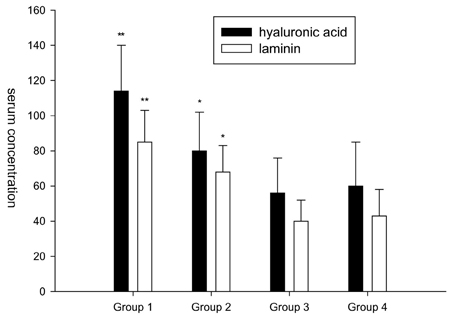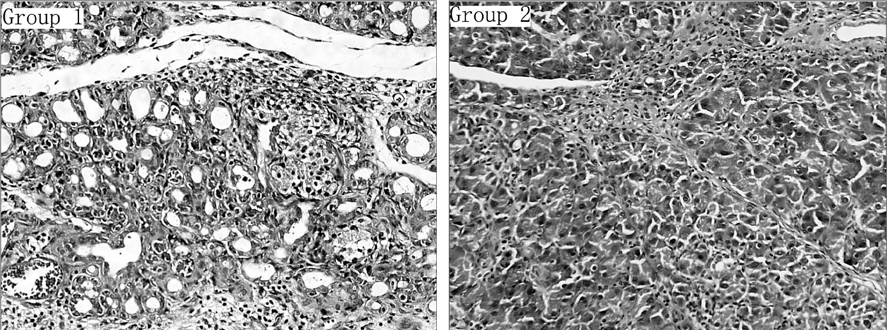Yonsei Med J.
2007 Dec;48(6):1028-1034. 10.3349/ymj.2007.48.6.1028.
Ascorbic Acid Alleviates Pancreatic Damage Induced by Dibutyltin Dichloride (DBTC) in Rats
- Affiliations
-
- 1Department of Gastroenterology, School of Medicine, Zhejiang University, Hangzhou 310009, China.
- 2Zhejiang Provincial Center for Disease Control and Prevention, Hangzhou 310009, China.
- 3Department of Pathology, Second Affiliated Hospital, School of Medicine, Zhejiang University, Hangzhou 310009, China.
- 4Institute of Clinical Medicine Research of Sir Run Run Shaw, School of Medicine, Zhejiang University, Hangzhou 310009, China. pancreas@126.com
- KMID: 1786220
- DOI: http://doi.org/10.3349/ymj.2007.48.6.1028
Abstract
- PURPOSE: Because previous studies have reported depleted antioxidant capacity in patients with chronic pancreatitis (CP), prevention of free radical production has gained importance in antifibrotic treatment strategies for CP. The aim of this study was to investigate the effects of ascorbic acid on oxidative capacity and pancreatic damage in experimental CP. MATERIALS AND METHODS: CP was induced in male Sprague-Dawley rats by infusion of dibutyltin dichloride (DBTC) into the tail vein. Ascorbic acid was given intraperitoneally at a daily dose of 10mg/kg body weight. The treatment groups were as follows: group 1, DBTC plus intraperitoneal physiologic saline; group 2, DBTC plus intraperitoneal ascorbic acid; group 3, solvent plus intraperitoneal physiologic saline; group 4, no operation plus intraperitoneal physiologic saline. Each group contained 15 animals. Treatment was started after CP was established. After 4 weeks of treatment, serum hyaluronic acid and laminin levels were determined by radioimmunoassay, pancreatic tissue oxidative stress was analyzed, and the degree of pancreatic damage was determined. RESULTS: Ascorbic acid treatment markedly increased superoxide dismutase (SOD) activity and decreased malondialdehyde (MDA) concentrations in pancreatic tissue (p < 0.01 for both). Significant serum hyaluronic acid and laminin reductions were observed in group 2 as compared with group 1 (p < 0.05). However, the serum hyaluronic acid and laminin levels remained elevated when compared with those of groups 3 and 4 (p < 0.05). Histopathologic scores were also lower in animals with CP that underwent ascorbic acid-treatment (p < 0.05). CONCLUSION: Ascorbic acid treatment alleviated the degree of oxidative stress and pancreatic damage in rat CP. Antioxidant treatment might be considered a potential option to improve the pathologic process in CP.
MeSH Terms
Figure
Reference
-
1. Apte MV, Wilson JS. Mechanisms of pancreatic fibrosis. Dig Dis. 2004. 22:273–279.2. Mas MR, Isik AT, Yamanel L, Inal V, Tasci I, Deveci S, et al. Antioxidant treatment with taurine ameliorates chronic pancreatitis in an experimental rat model. Pancreas. 2006. 33:77–81.3. Yoo BM, Oh TY, Kim YB, Yeo M, Lee JS, Surh YJ, et al. Novel antioxidant ameliorates the fibrosis and inflammation of cerulein-induced chronic pancreatitis in a mouse model. Pancreatology. 2005. 5:165–176.4. Kirk GR, White JS, McKie L, Stevenson M, Young I, Clements WD, et al. Combined antioxidant therapy reduces pain and improves quality of life in chronic pancreatitis. J Gastrointest Surg. 2006. 10:499–503.5. Matsumura N, Ochi K, Ichimura M, Mizushima T, Harada H, Harada M. Study on free radicals and pancreatic fibrosis--pancreatic fibrosis induced by repeated injections of superoxide dismutase inhibitor. Pancreas. 2001. 22:53–57.6. Altavilla D, Famulari C, Passaniti M, Galeano M, Macrì A, Seminara P, et al. Attenuated cerulein-induced pancreatitis in nuclear factor-kappaB-deficient mice. Lab Invest. 2003. 83:1723–1732.7. Padayatty SJ, Katz A, Wang Y, Eck P, Kwon O, Lee JH, et al. Vitamin C as an antioxidant: evaluation of its role in disease prevention. J Am Coll Nutr. 2003. 22:18–35.8. Eşrefoğlu M, Gül M, Ates B, Yilmaz I. Ultrastructural clues for the protective effect of ascorbic acid and N-acetylcysteine against oxidative damage on caeruleininduced pancreatitis. Pancreatology. 2006. 6:477–485.9. Du WD, Yuan ZR, Sun J, Tang JX, Cheng AQ, Shen DM, et al. Therapeutic efficacy of high-dose vitamin C on acute pancreatitis and its potential mechanisms. World J Gastroenterol. 2003. 9:2565–2569.10. Bhardwaj P, Thareja S, Prakash S, Saraya A. Micronutrient antioxidant intake in patients with chronic pancreatitis. Trop Gastroenterol. 2004. 25:69–72.11. Sparmann G, Merkord J, Jäschke A, Nizze H, Jonas L, Löhr M, et al. Pancreatic fibrosis in experimental pancreatitis induced by dibutyltin dichloride. Gastroenterology. 1997. 112:1664–1672.12. Ohkawa H, Ohishi N, Yagi K. Assay for lipid peroxides in animal tissues by thiobarbituric acid reaction. Anal Biochem. 1979. 95:351–358.13. Liu P, Liu CH, Wang HN, Hu YY, Liu C. Effect of salvianolic acid B on collagen production and mitogen-activated protein kinase activity in rat hepatic stellate cells. Acta Pharmacol Sin. 2002. 23:733–738.14. Nishikimi M, Fukuyama R, Minoshima S, Shimizu N, Yagi K. Cloning and chromosomal mapping of the human nonfunctional gene for L-gulono-gamma-lactone oxidase, the enzyme for L-ascorbic acid biosynthesis missing in man. J Biol Chem. 1994. 269:13685–13688.15. Nishikimi M, Yagi K. Biochemistry and molecular biology of ascorbic acid biosynthesis. Subcell Biochem. 1996. 25:17–39.16. Buettner GR, Moseley PL. EPR spin trapping of free radicals produced by bleomycin and ascorbate. Free Radic Res Commun. 1993. 19:Suppl 1. S89–S93.17. Bielski BH, Richter HW, Chan PC. Some properties of the ascorbate free radical. Ann N Y Acad Sci. 1975. 258:231–237.18. Kim H, Seo JY, Roh KH, Lim JW, Kim KH. Suppression of NF-kappaB activation and cytokine production by N-acetylcysteine in pancreatic acinar cells. Free Radic Biol Med. 2000. 29:674–683.19. Stevens T, Conwell DL, Zuccaro G. Pathogenesis of chronic pancreatitis: an evidence-based review of past theories and recent developments. Am J Gastroenterol. 2004. 99:2256–2270.20. Braganza JM. Pancreatic disease: a casualty of hepatic "detoxification"? Lancet. 1983. 2:1000–1003.21. Norton ID, Apte MV, Haber PS, McCaughan GW, Pirola RC, Wilson JS. Cytochrome P4502E1 is present in rat pancreas and is induced by chronic ethanol administration. Gut. 1998. 42:426–430.22. Packer L, Weber SU, Rimbach G. Molecular aspects of alpha-tocotrienol antioxidant action and cell signalling. J Nutr. 2001. 131:369S–373S.23. De las Heras Castaño G, Garcìa de la Paz A, Fernández MD, Fernández Forcelledo JL. Use of antioxidants to treat pain in chronic pancreatitis. Rev Esp Enferm Dig. 2000. 92:375–385.24. Blaisdell RJ, Giri SN. Mechanism of antifibrotic effect of taurine and niacin in the multidose bleomycin-hamster model of lung fibrosis: inhibition of lysyl oxidase and collagenase. J Biochem Toxicol. 1995. 10:203–210.
- Full Text Links
- Actions
-
Cited
- CITED
-
- Close
- Share
- Similar articles
-
- The Effect of Yacon (Smallanthus sonchifolius) Extract against Dibutyltin Dichloride-induced Pancreatitis
- The Effect of Ascorbic acid on Endotoxin-induced Fibrosis
- Role of ascorbic acid in dapsone induced methemoglobinemia
- Vitamin C causes lung damages in diabetic rats
- The Concentration of Ascorbic acid in Vitreous of Macular Hole Patients




